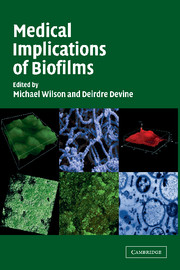Book contents
- Frontmatter
- Contents
- Preface
- List of Contributors
- PART ONE INTRODUCTORY CHAPTERS
- 1 Biofilm-Dependent Regulation of Gene Expression
- 2 Quorum Sensing and Microbial Biofilms
- 3 Antimicrobial Agents and Biofilms
- PART TWO BIOFILMS ON PROSTHETIC DEVICES
- PART THREE ORAL BIOFILMS
- PART FOUR BIOFILMS ON SHEDDING SURFACES
- Index
- References
3 - Antimicrobial Agents and Biofilms
Published online by Cambridge University Press: 23 November 2009
- Frontmatter
- Contents
- Preface
- List of Contributors
- PART ONE INTRODUCTORY CHAPTERS
- 1 Biofilm-Dependent Regulation of Gene Expression
- 2 Quorum Sensing and Microbial Biofilms
- 3 Antimicrobial Agents and Biofilms
- PART TWO BIOFILMS ON PROSTHETIC DEVICES
- PART THREE ORAL BIOFILMS
- PART FOUR BIOFILMS ON SHEDDING SURFACES
- Index
- References
Summary
INTRODUCTION: THE PROBLEMS
There is increasing concern over the role played by microbial biofilms in infection. These include well-known examples of medical device-related infections such as those associated with artificial joints, prosthetic heart valves, and catheters. Indeed, recent surveys indicate that catheter-associated bacteraemia, consequent from catheter-related infection, is by far the leading cause of nosocomial bloodstream infection in intensive care units (Brub-Buisson, 2001). Many chronic infections, not related to medical devices, are now recognised to be due to bacteria either not growing and relatively dormant or growing slowly as biomasses or adherent biofilms on mucosal surfaces. Thus, the question of how to treat biofilm infections extends to many aspects of medicine. Indeed, the issue of biofilm eradication extends way beyond the infected patient, since bacteria in the environment typically exist as biofilms. These are commonly complex multispecies ecosystems associated with protozoa (Brown and Barker, 1999). The biofilm mode of growth greatly enhances the survival of the constituent microbes.
Growth as a biofilm almost always leads to a large increase in resistance to antimicrobial agents, including antibiotics, biocides, and preservatives, compared with cultures grown in suspension (planktonic) in conventional liquid media (Gilbert, Collier, and Brown, 1990; Stewart and Costerton, 2001). However, a recent paper with high density planktonic cultures indicated similar resistance to antimicrobials as did biofilm cultures (Spoering and Lewis, 2001). Currently, there is no generally agreed mechanism to account for the broad resistance to chemical agents.
- Type
- Chapter
- Information
- Medical Implications of Biofilms , pp. 36 - 56Publisher: Cambridge University PressPrint publication year: 2003
References
- 3
- Cited by



